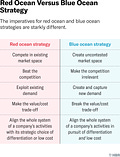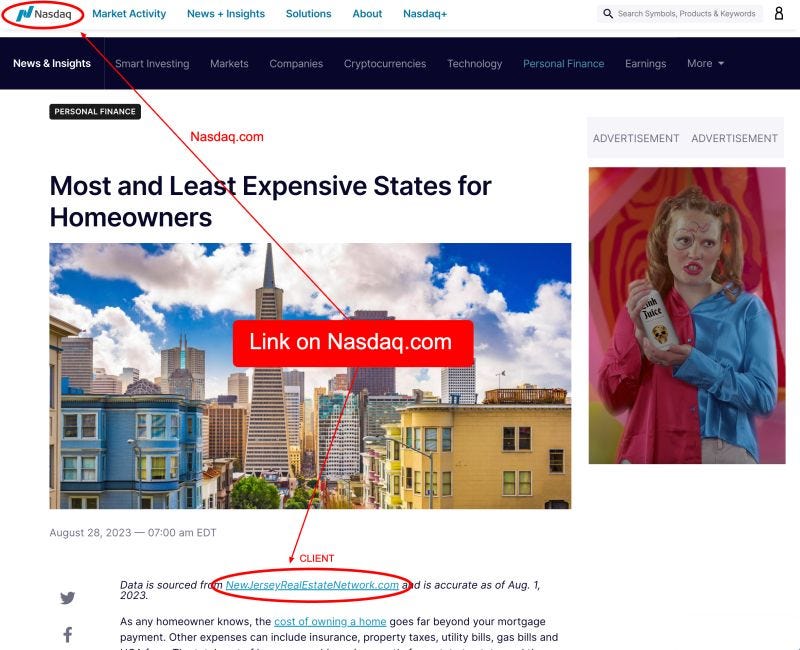This week’s newsletter is sponsored by the Digital PR agency Search Intelligence. See their case study at the end of the newsletter.
Many content and SEO campaigns suffer from a lack of creativity, so they use keyword or competitor research to seed their ideas. For those that have read anything I have written on Product-Led SEO and want to use this approach to grow their search traffic, they then try to shoehorn those uncreative ideas into a scaled product-led effort. It doesn’t usually work.
Instead, the right way to start a product-led SEO effort is to go where no one else has before; that’s an SEO Blue Ocean.
Defining Blue Ocean vs Red Ocean
In their bestselling book Blue Ocean Strategy, authors Chan Kim and Renée Mauborgne promote a creative marketing approach. They contend that companies compete in different markets in different ways.
The Red Ocean
When companies are in a known market space with defined boundaries, this situation should be termed a Red Ocean. In the Red Ocean space, companies must outperform their competition by differentiating on various points of value, offering, price, and experience. As the market gets more crowded, the competition becomes even more fierce, and profits decline for all players.
The Blue Ocean
In contrast, Blue Oceans are wide open spaces where industries do not yet exist. In this space, demand is created by the companies that enter it first. There is always a substantial profit potential. Within a Blue Ocean, there is no competition, and the market belongs to a single player. Others will become aware of the profit potential as the market matures, and the Blue Ocean could turn red.
Think of the ride-sharing industry as a prime example of the Blue and the Red industries. While Uber started as a car service dispatch company, Lyft created a brand-new ride-sharing industry.
With Lyft, people earned a few dollars to give someone a ride in the same direction they were traveling. Initially, this was a pure Blue Ocean, and Lyft had all the advantages of owning a market. Lyft could set prices, determine the rules, and build brand loyalty.
As customer adoption grew and this market expanded, other players—Uber included—decided to jump in too. Competition grew incredibly fierce as both companies undercut each other on price, products, and may have even used underhanded tactics (allegedly). Aside from Uber, other companies saw the profit potential and dove into this market. Ridesharing became a classic Red Ocean.
Red Ocean SEO
The idea of Blue Oceans vs Red Oceans is appropriate for thinking of the state of SEO and content marketing today when the entire SEO plan is developed from keyword research and is even more acute when it starts with competitor research.
This research data is available to anyone and is not at all unique.
What “available to anyone” means is that anyone with a browser can find these keyword ideas and then write content targeted at the listed search volume keywords.
Content of the Red Ocean type becomes a race to the top (but in reality, it’s a race to the bottom) of who can write longer, have more research, build better links, and dominate search.
The focus of the Red Ocean SEO isn’t really on the user, even though everyone claims to be user-centric. The goal of a Red Ocean SEO strategy is to be valued by Google. The content begins and ends the creation process with keyword research. Yes, it might be written in tone and quality that’s supposedly geared to the end user, but if the content never achieves its predicted ranking dominance, it is deemed a failure. Google is the audience.
Blue Ocean SEO
On the other hand, Blue Ocean SEO is the complete opposite. A Blue Ocean-type SEO strategy would begin with a hypothesis about users and their potential demand. There is no keyword research to support the marketing effort; only customer research can be relied upon.
My favorite tool for uncovering these ideas is talking to the user. This can be accomplished with surveys, customer data, or a person-to-person conversation.
The content is created completely with the user in mind because the marketing team knows that the users will find and appreciate the content. The content creation can be written manually, targeting a keyword, or better yet, the product is built around it, and this becomes product-led SEO.
Blue Ocean SEO never ends
When approached this way, there will never be an end for the content and the resulting search that can be created. Each time a new user scenario is addressed with content for the first time, it will create a category that will unlock even more user scenarios and demand, and the cycle will continue in perpetuity.
Focusing on the user with Blue Ocean SEO always keeps the SEO strategy ahead of the curve. It avoids the natural lifecycle that decays the search potential of a site that focuses only on Red Ocean keywords.
As a loose example of this, imagine a site that reviews iPhones. If they were to rely on keyword research, their primary keywords and content would all be focused on the names of the released and about-to-be-released models with known features. The search volume for these keywords will continue to decay until it reaches zero as Apple updates its products.
If the growth team completely ignored keywords and instead built their content strategies off of user research, they would put effort into the topics they hear that users want to know about. There is still decay in demand, but they are supplementing and insulating against the decreases by staying ahead of the curve for search demand rather than behind it.
More than likely, the user research would allow them to find hidden ideas (hot pink iPhone, anyone?) to write about that the Apple product team probably knows about from their own research. Still, other sites would not address this because they only use keyword research. If these ideas made it into a product release, our forward-thinking site could own the traffic for some time, but if it didn’t, they would still have substantial traffic driven by the user cohort that is curious about this topic.
Blue Oceans will always lead to new Blue Oceans, and a user-focused SEO strategy can drive growth forever, even when search engines change algorithms or even when search engines swap market share.
[Sponsored]
This campaign earned links on Nasdaq, Entrepreneur, Yahoo News, and 10 other websites by analysing US census data.
This is how we've done it:
✅ We analysed US census data to find the average yearly housing cost in each state as a proportion of median income.
Housing costs included:
- Mortgage repayments
- Various insurances
- Property taxes
- Utility bills
- Fuel bills
- Mobile home costs
- Condominium fees
✅ The data revealed that:
Read MORE




Amazing!